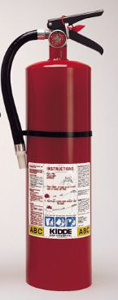Library Contents Search the Library RV Tech Library Help Page Site Map About Us Tiffin RV Network TRVN Classifieds Campground Reviews Photo Gallery TRVN Store
Appliances Batteries Boondocking/Dry Camping Chassis Clubs & Forums Electrical Electronics Engines Exterior Maintenance Generators Heating & Air Conditioning Interior Maintenance Misc Items Operating Tips Plumbing Red Bay Safety & Health Storage Supplier Contacts Tires and Wheel Rims Towing Transmissions Weighing

Fire Extinguishers
Types of Fires:
Fire extinguishers are a very important safety item. RVs are built with plenty of flammable materials and in the event of a fire, that fire will spread fast and far and you will have very little time to either fight it or evacuate. Most RVs come equipped with a single fire extinguisher of minimal size. However, the best recommendation is to have three extinguishers on board. In the event of a fire you’ll need it to be of adequate size and it will have to be easily accessed in a hurry. The typical fire extinguisher located by the front door does little good if the fire starts mid-coach while you are sleeping at night. You’ll need a second fire extinguisher located back in the bedroom area if you want to have any chance of stopping that fire. A third fire extinguisher should be located in a curbside basement storage compartment. I you have a fire outside the coach, in the engine compartment, on any towed vehicle or even in the entry way to the coach you'll need fast exterior access to it. It’s also recommended that you upsize your fire extinguisher to a larger size so that you will have adequate fire retardant to stop the fire.
Fire Extinguishers are classified by letters and numbers according to the class and size fire they can put out. The letter, (A, B, C, or D) indicates the class of fire. The number is a measure of the capacity of the extinguisher - the larger the number the greater the capacity to put out a fire.
|
"A" is for combustible solids like wood "B" is for flammable liquids such as gasoline "C" is for electrical fires. "D" is for combustible metals like magnesium |
|
Although some fires involve burning wood and paper (Class A), and they can be put out with water, do not use water on gasoline,
oil, or electrical fires. Water causes gasoline and oil fires to spread and electrical current is conducted through the water.
Classes of Fire Extinguishers:
| Type of Extinguisher | Class of Fire | Notes: |
| Carbon Dioxide (C02) | B, C | Carbon Dioxide is a class B, C, agent only. Because of the CO2 high pressure, it is not recommended for use on Class A, ember
and ash based fires. Why? Because of the hazard of spreading the fire when blasting it with the high pressure gas. |
| Halon (until year 2000) | A, B, C | Halon 1211 carries the A, B, C rating only in a capacity of 9 pounds. Units smaller than 9 pounds only carry the B, C rating.
Halon gas vaporizes too quickly to maintain a Class A fire in small quantities. Halon was removed from the worldwide market due to concerns about
suffocation if inadvertently tripped. |
| Dry Chemical | A, B, C | Dry chemical extinguishers come in three varieties. Sodium Bicarbonate B, C (Alkaline); The A, B, C dry chemical is popular but has it’s drawback for two reasons:
|
| Foam | A, B | Foam extinguishers are water based and quench Class A fires. They also blanket, smother and separate the vapor layer
in Class B fires. |
Important!
Fire extinguishers are not the same as fine wine. They DO NOT get better with age. It is important that you have your fire extinguisher serviced on an annual basis. Even if the pressure has not leaked down, after a few years any dry chemical compound may pack up to the point where the fire extinguisher won't perform when you really need it. Good quality fire extinguishers with metal cases can be serviced and recharged indefinitely. However, with some inexpensive plastic housing models you may find it easier to just replace them as they are not designed to be disassembled and reassembled without creating leakage problems.
The RV Tech Library is brought to you by the TiffinRVnetwork
Absolutely No Affiliation exists between this group and Tiffin Motor Homes Inc or the Allegro Club. This website neither endorses or discourages the use or purchase of a Tiffin product. All references, suggestions, comments, etc. contained herein are the opinions/experiences of the posters and not those of Tiffin Motor Homes Inc. or the website administrators.




